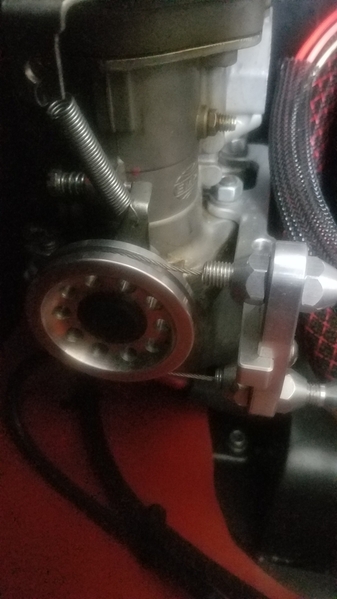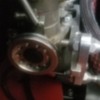So, all this talk of carb whispering takes me back to the first Speedster I had.
It was a CMC, built in SoCal by a guy who subcontracted work to all the usual places. It had a Kirk-n-Mary interior, a quick-n-dirty paint job, and the finest Serrano 1776 money could buy.
Serrano went out of business sometime in the last 20 years, but Steve firmly held down the bottom end of the Type 1 market at a time when the bottom end was right down there. I got invoices with the car - I think the cost for a 1776 with a set of dual 40 IDFs was $1250 or some such thing. It was nothing but the finest - a Cima/Mahle piston/cylinder set, a 110 cam, and an EMPI carb set.
It was my first experience with such exotica, and it was not an auspicious start. I was completely and horribly lost. The CBP Weber "Bible" everybody was toting here was more of a folksy vanity project for the Bob Tomlinson family - it's pretty much useless for anything beyond lining a bird cage.
There were no threads on any of the forums written by people who understood how to set up duals and had a knack for explaining things, so I had no idea where to start.
I turned to AJ Sims (also a darling of this site, back in the day), who sold me a set of his "hot-rod" Kadrons. They were far, far worse than the IDFs - unworkable junk. Art Thraen rescued me by selling me a set of Dellortos set up pretty closely to what I needed, and I applied myself to learning what the heck was going on. I bought an LM1 A:F meter, and ended up buying four of every idle jet CB sold, about 50% of the mains, and a wide range of air-correction jets. It was overkill, for sure - but I was committed. I put CHT gauges on all 4 cylinders, and I could see which idle jet was plugging from inside my car.
I cracked the code by carpet-bombing the problem with time and tools and reading.
Eventually, it just became second nature. I don't need a hundred jets - because 4 or 5 sets will cover 99% of ACVWs out there. Same with mains - a handful will do it. Air correction is almost never the issue.
Those CHT gauges? A $15 infrared thermometer does the same thing.
I'm self-taught because I had to be. I bought all the tools because that's who I am. Better men than me figure it out without spending a couple of thousand bucks on meters and jets, but that's what it took for me to crack the nut.
I'm not trying to come off as a know-it-all, because I'm the dim bulb in the back of the class who got it done by persistence.
If you can sync your carbs, you're 90% of the way there, and it only takes 50 bucks for a snail and reading and rereading the instructions above and elsewhere.
Step 1: Start off with a Weber kit, not the EMPI clones. Some guys have made the EMPI stuff work - if you're new to all of this, you won't be one of them.
Step 2: Buy the CB hexbar kit, or a sync-link setup. Again, the EMPI stuff can work, but it'll never be elegant and you'll always fight the slop built right in ("EMPI Carb Linkage: The Slop Goes in Before the Name Goes On").
Just say "no". Nay, I say. Nay.
The Scat/CSP/Vintage Speed push-pull linkage is great, but all of the advice is going to be for the CB kit. If "you're on your own" sounds good, knock yourself out.
Step 3: Your carbs are going to come set up jetted fat, but just live with that for a bit. It's the sync where you should start. Follow the instructions above. Valves first, then timing, then sync. Don't hop around. Doing two things at once is a bad way to do this.
Step 4: Once you have a perfect linkage, you can move on to the mixture screws. Start by getting familiar with how to adjust them. I'm oversimplifying it by saying it this way, and I'm definitely not going to say it doesn't matter (it does!) but I will say that even if you're jetted too fat and your mixture screws are backed way the heck out - too rich is better than too lean.
It's important to remember that of the 4 adjustments (valves, timing, sync, and mixture screws) the mixture screws are the least important and the last to get done. They're really only a thing at idle and just off - open the throttle plates much at all, and you start exposing transition ports, which means that needle in that little hole means a lot less.
The operative thing here is to not get lost with where you are. If one screw is good at 2 turns out, and another one is set at 3/4 turn out - something is wrong. There's been a lot written about this - but it's pretty straightforward. Turning the mixture screws in (CW) leans the burn at idle, turning them out (CCW) fattens it up. turn them in at idle until you hear (or see on a tach) the RPM start to drop (lean misfire), then fatten it up 1/4 to 1/2 turn. There are better and more precise methods, but this gets you close.
Step 5: If you've done all this, and you still aren't happy - God love you. You're one of His special children. To go further, you'll need a bung welded in the collector of your header (or just after) and an A:F meter. I have no idea what you should buy, because I bought the LM1 which was state of the art 15 years before I bought it 10 years ago, and it cost about $300. It works perfectly. Somebody out there probably found one on amazon or eBay for $14 and 24 Sam Adams bottle caps, but I'm not that guy.
All I know is that you want a wideband. Narrowband is for folks smarter than guys just starting out, and you're on the front end of this. Just get a good one. If you can't rely on it, you'll be guessing.
There's so much more - but that's the beginning. Get it under your nails, and you'll start wanting more. Before long, you'll be doing the math in your head to figure out what time it is in Mike Pickett's world.








